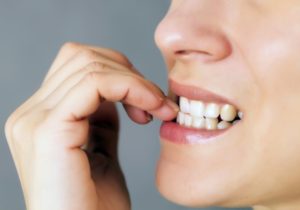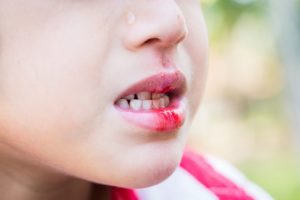We all hear about foods that are bad for your teeth! Sticky sweets and sugar-laden sodas can wreak havoc with your pearly whites. But did you know there are also foods that are good for your teeth and gums? Here is a list of dentally healthy things to chomp on, courtesy of your friends at Drs. and Badger’s office!
1. Cheese. Maybe there’s a reason that when we “say cheese” it’s time to smile! With high levels of phosphate and calcium, cheese promotes healthy teeth, balances the oral ph, and can destroy bacteria that cause cavities and gum disease.
2. Dairy products. Other than cheese, milk and yogurt are rich in calcium and low in acidity – both positive things for your teeth and gums.
3. Green tea. This delicious drink is an anti-oxidant soup which prevents plaque from accumulating on your teeth, reducing cavities and bad breath. Just take it easy on the added sugar and honey!
4. Kiwi. Most fruits are loaded with Vitamin C, and eating them raw can give your gums a good healthy massage as well. Kiwis are exceptionally high in Vitamin C, which can increase the collagen in your gums and make them stronger.
5. Onions. Sure – raw onions can make your breath pretty smelly. But the sulfur compounds that contribute to temporary bad breath also kill dangerous bacteria that harm the teeth. Brush, floss and rinse after you eat them, or better yet – make sure your kissing partner eats them too!
6. Celery. Eat plenty of celery and you may not have to stalk your dentist as much! Raw celery massages your gums, and can increase the production of healthy saliva.
7. Sesame seeds. These little wonders actually can scrape plaque from your teeth and are packed with tooth-strengthening calcium. The bleached white flour bagel they are often attached to – that’s a different story.
8. Sweet potato. These beauties are loaded with Vitamin A, and are especially good for babies whose teeth are developing. An orange nose is an added bonus!
9. Shiitake mushrooms. Believe it or not, these tasty fungi often found in Asian foods contain a sugar that prevents plaque from forming on your teeth.
10. Water. There’s a reason water is called “the gift of life,” and you would be hard pressed to find a healthy foods list without it. Dentally speaking, water keeps your mouth hydrated, cleans and rinses your teeth and gums, stimulates saliva production, and can dislodge trapped food particles.
As great as these foods are, there is much more to healthy teeth and gums than loading up on celery, cheese and water! If it is time for your regular dental examination and cleaning, or if you have any questions at all about your dental health, we are here for you! Please give us a call at 850-878-4117.


 As we near the end of 2018, your to-do list is probably filling up with holiday parties, gatherings, and a number of other fun events. Before things get too crazy during November and December, why not take a few steps to ensure that you are getting the most out of your dental insurance coverage? Each year, Americans waste literally billions of dollars in unused insurance benefits — but it doesn’t have to be that way. Keep reading to learn how a visit to the dentist in Tallahassee can help you save big before the year is up… for the benefit of your smile AND your wallet.
As we near the end of 2018, your to-do list is probably filling up with holiday parties, gatherings, and a number of other fun events. Before things get too crazy during November and December, why not take a few steps to ensure that you are getting the most out of your dental insurance coverage? Each year, Americans waste literally billions of dollars in unused insurance benefits — but it doesn’t have to be that way. Keep reading to learn how a visit to the dentist in Tallahassee can help you save big before the year is up… for the benefit of your smile AND your wallet. While you may know to call an ambulance when an emergency is happening, what do you do if you or someone you know sustains an injury local to the mouth or teeth? Is it worth it to call an ambulance at that point? Should you try to schedule a visit to the dentist instead? What if you wake up to severe tooth pain? What’s the best plan of action then?
While you may know to call an ambulance when an emergency is happening, what do you do if you or someone you know sustains an injury local to the mouth or teeth? Is it worth it to call an ambulance at that point? Should you try to schedule a visit to the dentist instead? What if you wake up to severe tooth pain? What’s the best plan of action then? A dental emergency in Tallahassee will happen when you least expect it, and the severity of it can vary. Some emergencies are considered low-level and can be temporarily stabilized at home, while others require more immediate attention. As you read on, your local dentist explains the difference between the two and what you should do for each type of .
A dental emergency in Tallahassee will happen when you least expect it, and the severity of it can vary. Some emergencies are considered low-level and can be temporarily stabilized at home, while others require more immediate attention. As you read on, your local dentist explains the difference between the two and what you should do for each type of . If you need a new family dentist in Tallahassee, you can easily become overwhelmed when looking for the perfect one while searching the web. The options are practically limitless online!
If you need a new family dentist in Tallahassee, you can easily become overwhelmed when looking for the perfect one while searching the web. The options are practically limitless online! Porcelain veneers in Tallahassee
Porcelain veneers in Tallahassee If you’ve been wondering how to get a smile like your favorite celebrity, your cosmetic dentist in Tallahassee is here to share the secret stars have been keeping to themselves: porcelain veneers! Ready for a complete smile transformation? Learn more about this modern “smile makeover” here.
If you’ve been wondering how to get a smile like your favorite celebrity, your cosmetic dentist in Tallahassee is here to share the secret stars have been keeping to themselves: porcelain veneers! Ready for a complete smile transformation? Learn more about this modern “smile makeover” here. Boys will be boys, right? You’ve always heard that but your son has really brought that saying to life—unfortunately. Sometimes you watch your little one and wonder, “Why?” as he decides to climb to the top of the monkey bars and riskily try to balance his way across them.
Boys will be boys, right? You’ve always heard that but your son has really brought that saying to life—unfortunately. Sometimes you watch your little one and wonder, “Why?” as he decides to climb to the top of the monkey bars and riskily try to balance his way across them.